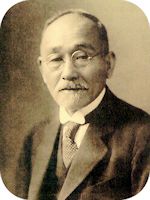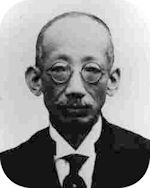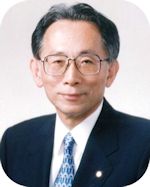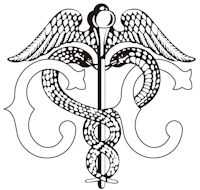|
One day, in the afternoon with early summer breeze, Taisho 14 (1925), Zensaku
Sano, president of Tokyo Commercial College (TCC), with Prof. Mitsuki Hori,
his right hand, and Prof. Torajiro Takagaki, his follower, entered the
main gate of Tokyo Imperial University (TIU).
This gate was designed by Prof. and Dr. Chuta Itoh for welcoming Emperor
Meiji in July, Meiji 45 (1912), 13 years before this date. It is an iron
gate supported by granite pillars. The emperor passed away 20 days after
going through this gate.
Straight ahead of them stands Yasuda Auditorium of Gothic style soon in
completion. Its construction started by Shimizu-gumi Company three years
ago in Taisho 11 (1922) and it is going to be completed after one month.
Surely it is a huge and gorgeous building with the budget of one million
yen, donated by Old Zenjiro Yasuda, the leader of Yasuda conglomerate.
Three of them stopped and watched it.
---
They walk along the stone-paved path, then turn to the right at the row
of ginkgoes.
The building of Engineering where Dr. Itoh works is directly across Sanshiro
pond.
A staff guided them to the meeting room. Matsushiro Fujii, director of
Kanematsu Company, is already here. He is one of the responsible executives
for the donation. They bow each other.
Soon Dr. Itoh appeared with a couple of people.
All the visitors stand up and introduce themselves respectively. Then the
director of General Affairs Dept. introduces Dr. Itoh, not forgetting to
say that he assumed the member of Imperial Academy and is spending busy
days.
Dr. Itoh is a man of medium height and build with a face of a sparse mustache
and a Fu Manchu beard, wearing no-rim glasses. The white hair is remarkable
both on the thin head and the beard.
Different from the visitors' expectation, he does not look arrogant at
all. If wearing work clothes, he would be mistaken as a gardener. It is
unbelievable right away that 30 years ago he was that scholar who swayed
Japan by writing the doctoral dissertation "The Theory on the Architecture
of Horyuji Temple."
The theory's main point was:
The pillars of the Chumon gate of Horyuji Temple is called "doubari", all of which swell in the middle. The origin of this shape dates back to the Parthenon in Greece.
The pillars consist of the curve so-called "entasis". ... I deeply
believe it on the basis of such facts historically observed with the result
of the transportation between the East and the West. |
|
This theory is not accepted by specialists so far as they say no evidence
has been found yet.
However, Dr. Itoh, four years after writing the theory, carried out the tour from China through Myanmar, India, Turkey, Egypt, Greece, France, Germany and the adjacent countries for three years and a half on the pretext of studying in Europe.
During the tour, he sometimes went over wildernesses sitting astride a
donkey, lost a dependable attendant on the way, and barely died of illness
himself. As such, it was really a severe tour, which proves he had an extraordinay
will, not to mention an unusually grand talent.
---
 That man, now the authority of the architecture field, is meeting Zensaku
Sano, president of TCC. That man, now the authority of the architecture field, is meeting Zensaku
Sano, president of TCC.
Next, making the visitors relaxed by telling them he does not accept anything
from outside during the meeting, Dr. Itoh introduces the staffs. Firstly
nodding to the gentleman with a bow tie next to him,
"I asked Mr. Minobe to join us."
Dr. Tatsukichi Minobe gives a slight bow to Sano in a smile. He serves
as both professors of TIU and TCC.
 Dr. Minobe is already noted as a constitutional scholar. He is tall, thin-hair and with gentle eyes through round-rim glasses, wearing a gray suit with a white handkerchief in a chest pocket. He is five years younger than Dr. Itoh. Dr. Minobe is already noted as a constitutional scholar. He is tall, thin-hair and with gentle eyes through round-rim glasses, wearing a gray suit with a white handkerchief in a chest pocket. He is five years younger than Dr. Itoh.
Then Dr. Itoh introduces another man.
 "This young gentleman is Mr. Kakuhei Matsui, my pupil. He helps work
with me diligently, while he is going to succeed his father's construction
company." "This young gentleman is Mr. Kakuhei Matsui, my pupil. He helps work
with me diligently, while he is going to succeed his father's construction
company."
Matsui nods politely to the visitors. He is well called a man of resolute
character, at about the age of 30, with a firm dark-skinned look.
---
"May be heard of ?"
Sano, representing the visitors, begins his talk.
"We intend to move our Kanda campus to Yaho Village located between
Kokubunji and Tachikawa Town, where the present wilderness is going to
be cultivated to a school city with our college in the center. Among the
plans of our new campus, we wish to build our proud auditorium hopefully
comparable to Yasuda auditorium of your university. Yasuda Auditorium is
overwhelmingly beautiful as it is reputed to be."
Dr. Itoh gives him back an ambiguous smile for his compliment with a serious
look.
This auditorium is not his work, but the one by Shozo Uchida, his colleague,
and Hideto Kishida, his pupil.
As Sano, in a moment, might think he should not have said so, he shows
some confusion, but continues his talk like with second thoughts.
"We are lucky that Kanematsu Company of Mr. Fujii as a director decided
to donate 500 thousand yen for the construction of our new auditorium,
so we are now working out a large-scale plan. When it is completed, we
will name it Kanematsu Memorial Auditorium after the precious thought of
all the staffs of Kanematsu Company and the founder Old Fusajiro Kanematsu."
Dr. Itoh answers in a friendly manner, back to his usual appearance.
"I have heard about your present situation from certain sources. Dr.
Minobe earnestly explained to me, too."
The president Sano becomes relieved since he has been worried about the advance information that he is rather insistent.
Contrary to Dr. Minobe's open-minded smile, the other visitors have not
been able to overlook the slight change of Dr. Itoh's expression just a
moment ago, so they are uneasy inside.
Sano sits up straight, pauses for a second and restarts his talk.
"Our school was founded as a private one of Mr. Arinori Mori for the
first time. But it afterward was under the control of Metropolitan Tokyo,
and became a national college in Meiji 18 (1885), when "Mercury"
was officially designated for the school badge."
 He shows the real fan-large badge to Dr. Itoh, who gazes it in hand. He shows the real fan-large badge to Dr. Itoh, who gazes it in hand.
"This is the pattern after the stick held by Hermes in Greek mythology
(Mercury in Roman mythology), so the badge itself is named Mercury. Two
snakes get tangled around the stick. We regard the snakes as Gembu which
is got tangled by a snake and a turtle. Gembu is one of the Four Gods with
Suzaku, Byakko and Seiryu in a Chinese legend. In the result, the Four-God
Statues have been the symbol of our college."
Sano puts on the table the crests of the other three sacred animals side
by side, which are all Chinese style and awe-inspiring caricature relieves.
Dr. Itoh watches them with some interest. Then he immediately gets his
eyes back to Sano, who speaks more in a calm way.
"As you may know, the boat race is a school sport we put the most
emphasis on, so the regatta with your university is the big annual event
of our school wholely. The name of the boat-club alumni is Shishin-kai
(Four-God Club) and the manager is myself as the president of TCC."
Dr. Itoh is watching Sano in a relaxed manner.
"The patterns of these Four Gods are the design created in Meiji 22
(1889), when the alumni built the four boats for six crews each in the
first place of our own. Since then Four Gods have actually a spiritual
support as the banner of the school."
Sano sums up the school history until the Shinyu Case.
Whether would it be good or not to talk about the facts since then as they
were? Then actually the details stimulate TIU of the stronghold of the
government system, in which there would be numbers of unpleasant things
to TIU. But without this talk the whole story would not hold up.
The director of General Affairs, sure enough, turns his face a little away.
Hori and Takagaki among the visitors have a worrying face. To the contrary,
Dr. Minobe is in clear eyes. Dr. Itoh does not change his eyes sticking
to Sano.
Sano does not flinch away from his talk.
"We know quite well about your social position, and also your own
busy days of designing and architecture work. But, ..."
He opens the document in hand.
"I hear that the grave of Count Tosuke Hirata, your uncle, is just
before completion and other several works are on the way. Also I hear a
couple of works by the request of Old Kihachiro Okura such as his residence
in Kyoto, Gion-kaku Shrine and Okura Museum. So, I understand you are too
busy every day in addition to your job as a professor."
Sano talks, fixing his eyes on Chuta Itoh, too.
"We are visiting you here with our heart to ask you definitely to
accept our project though we know it must be impossible in a common sense.
Without your design on the other hand our real thought is never achieved.
It is the whole idea of our college as well as my wish from the bottom
of my heart, because ..."
The outline of Sano's wish he appealed to Dr. Itoh is as follows. Dr. Itoh
looks mild for himself but is listening to him seriously for sure.
| A |
We aim to build an auditorium with the school tradition of the standard
for freedom, autonomy and culture. |
| B |
It should be such a symbolic building as to be engraved with the background
of the school history and to be succeeded through generations. |
| C |
For this purpose it should have the Four-God Statues, which have been getting along together and connote the spirit of the people having supported the school, on the facade as the most suitable location, and so it should be a banner in the future. |
| D |
It is well known to us that Dr. Itoh designed Heian Shrine in Kyoto in
his graduate school days first in his architectural life, and has achieved
a lot of noted buildings until now. Through each of these buildings we
have admiration and sympathy. |
| E |
In light of Dr. Itoh's idea that "archtecture is not merely to construct
a building but an art", and his lot of experiences according to his
thought, he is the only person that we would very much like to ask to build
our new auditoium with the symbolic Four-God Statues as a proud hall of
study.
We wish it would be a monument of Dr. Itoh's solid architectural thought. |
|
|